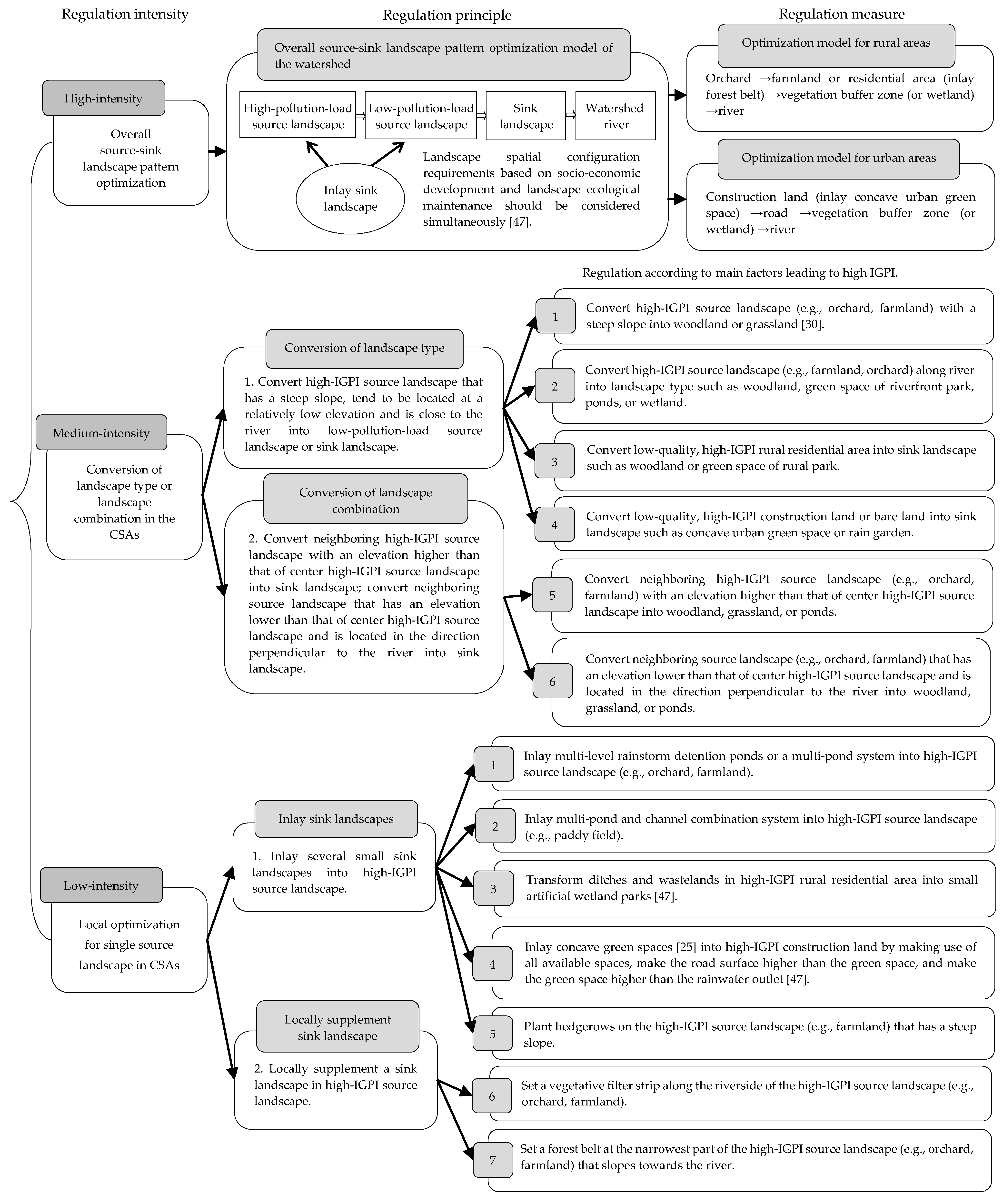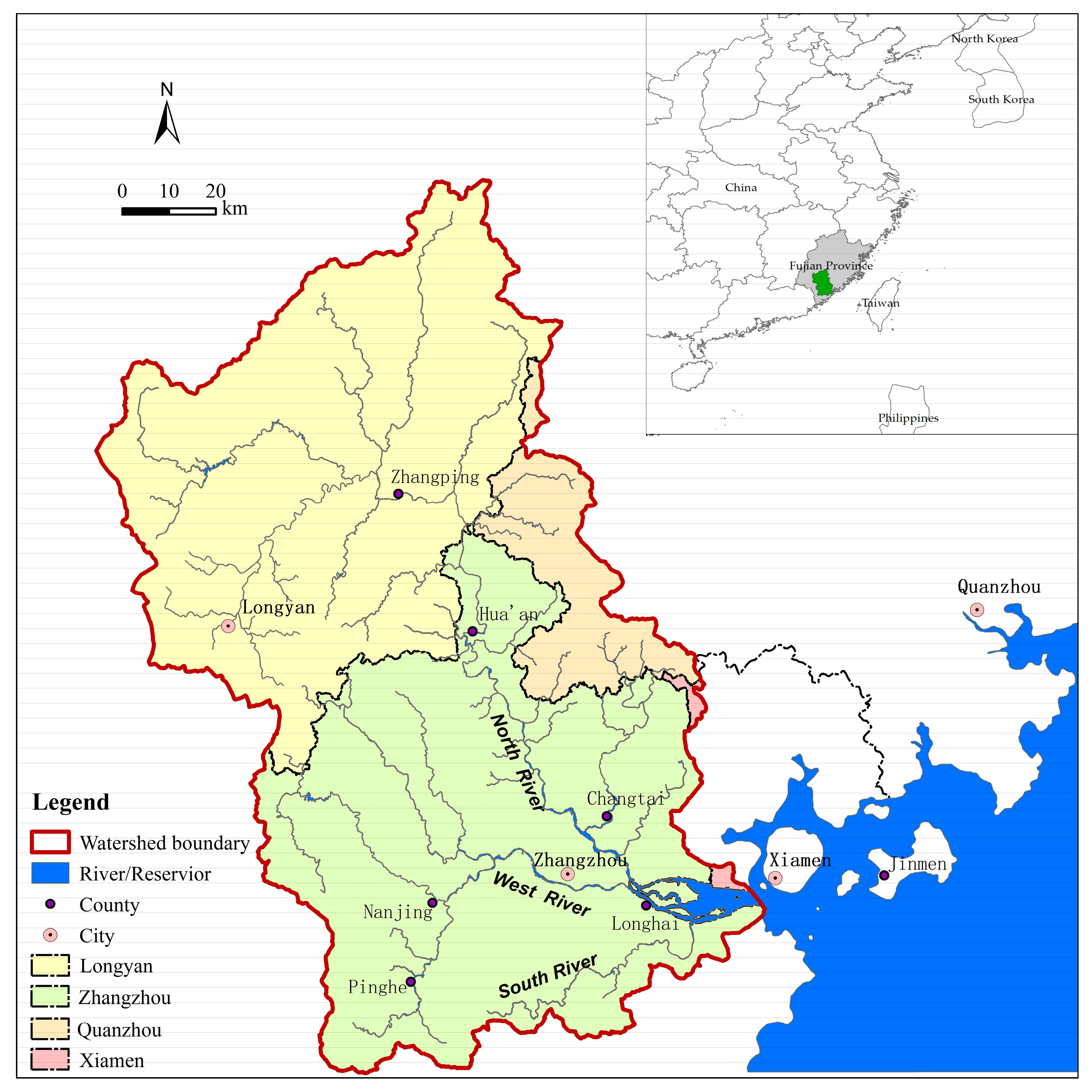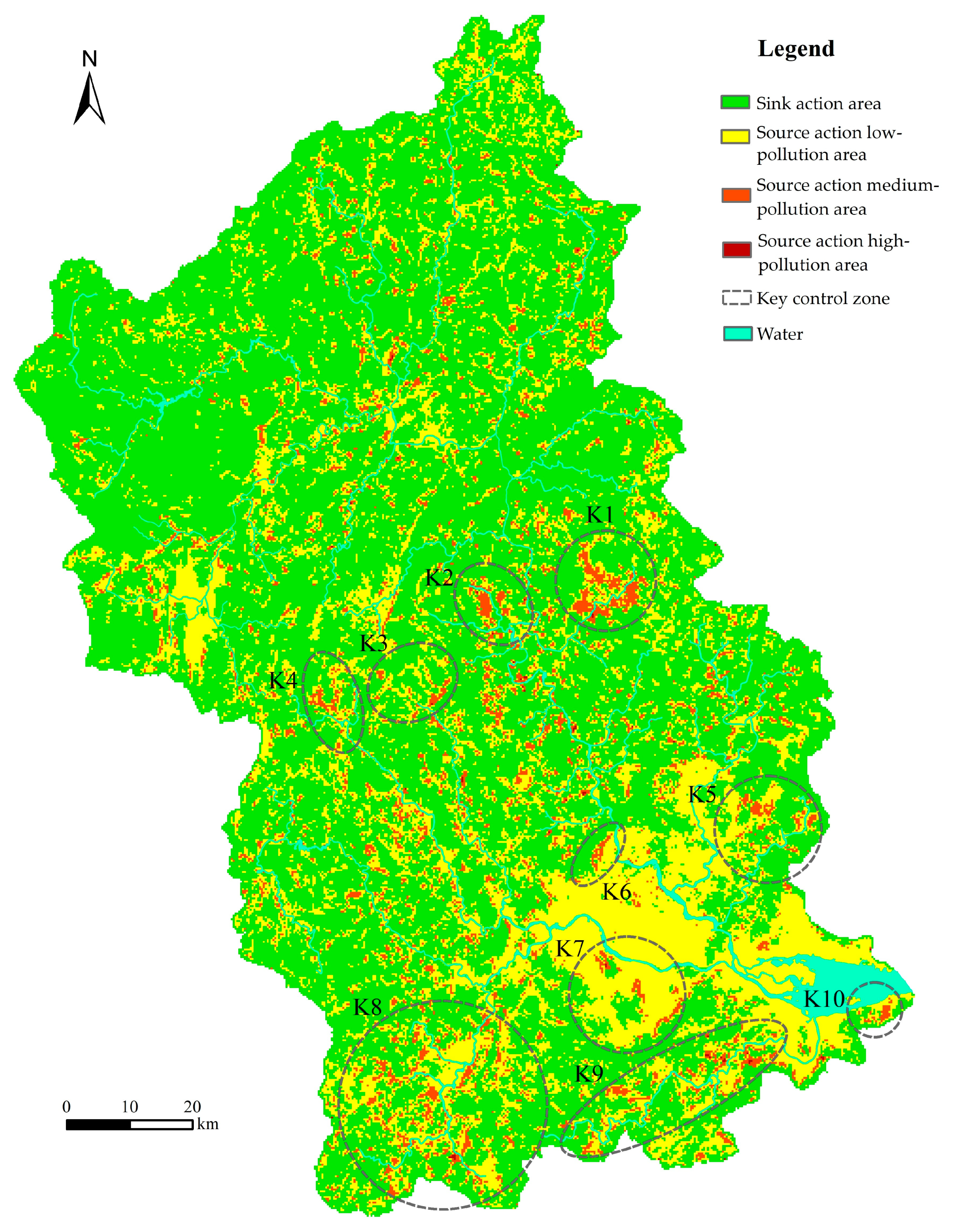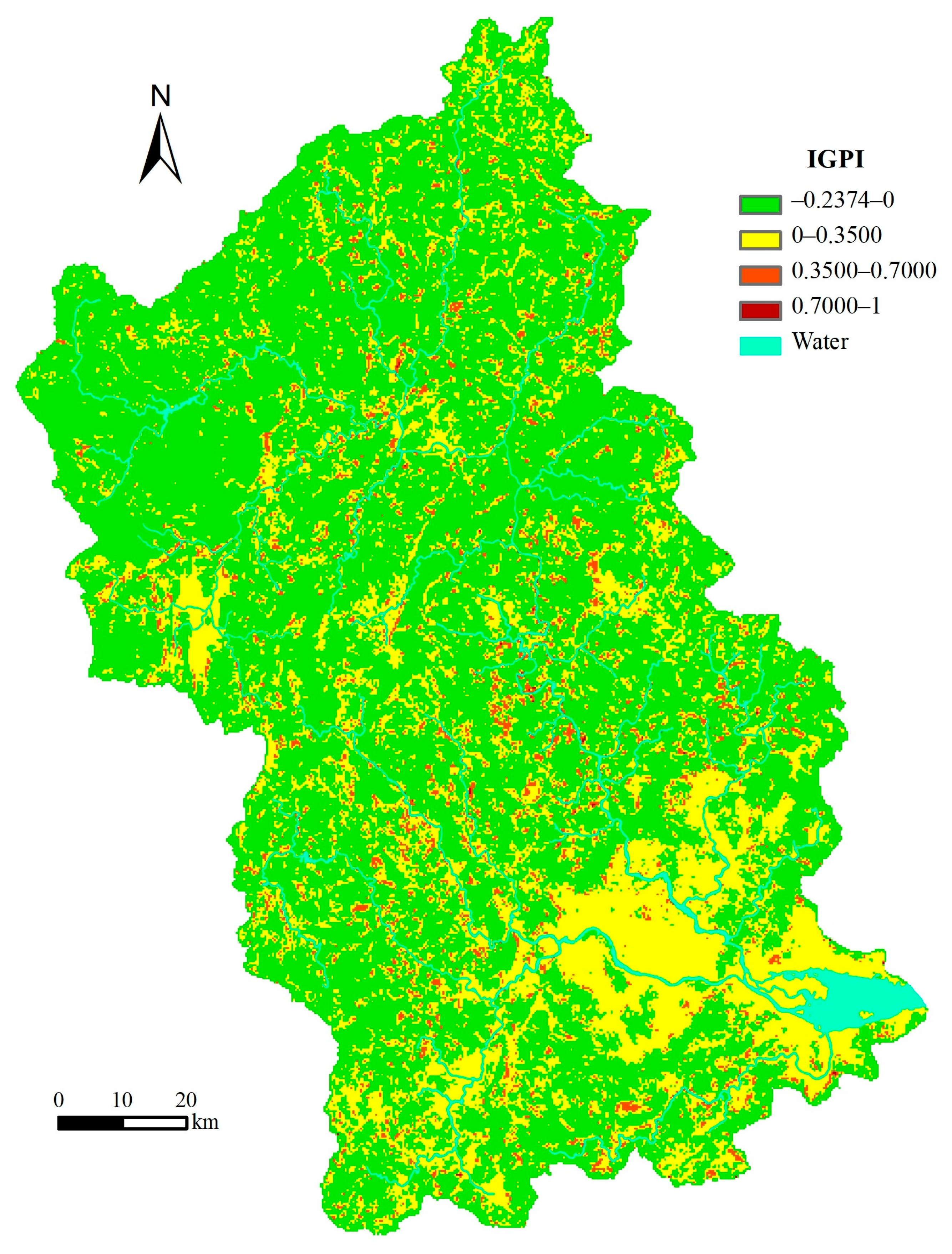Identification and Regulation of Critical Source Areas of Non-Point Source Pollution in Medium and Small Watersheds Based on Source-Sink Theory
Abstract
:1. Introduction
2. Methods
2.1. CSAs Identification Model Based on Source-Sink Theory
2.1.1. Determination of Grid Source-Sink Landscape Index
2.1.2. Standardization of Three Geographical Factors in the Grid
2.1.3. Determination of Grid Pollution Index
2.1.4. Determination of Neighborhood Impact Index
- (1)
- NII calculation of each neighboring grid
- (2)
- Total neighboring impact index calculation
2.1.5. Determination of Integrated GPI
2.1.6. Calculation Procedures
2.2. Comprehensive Regulation Strategy Formulation
2.2.1. Regulation Principles and Contents
- (1)
- High-intensity regulation—overall source-sink landscape pattern optimization: based on the suitable positions of source and sink landscapes in terms of the distance from the river, relative elevation, and slope, an overall source-sink landscape pattern optimization model for the watershed was constructed and used as a macro regulation strategy of CSAs. Meanwhile, the requirements of watershed landscape spatial configuration based on socio-economic development and landscape ecological maintenance should be considered [47].
- (2)
- Medium-intensity regulation—conversion of landscape type or landscape combination in CSAs: at the meso-scale, as a reasonable combination of source and sink landscape can produce fewer NPS pollutants, high-IGPI source landscape can be converted into low-pollution-load source landscape or sink landscape, and for high-IGPI source landscape that is significantly affected by the neighboring landscapes, the neighboring source landscapes that significantly impact the aforementioned landscape can be transformed into sink landscape. Taking the above as the regulation principles, a series of corresponding regulation measures was formulated considering the landscape characteristics of urban and rural areas and the needs of socio-economic development. In actual regulation, appropriate regulation measures can be selected based on the main factors that lead to high IGPI.
- (3)
- Low-intensity regulation—local optimization for single source landscape in CSAs: at the micro-scale, for single high-IGPI source landscape in CSAs, several small sink landscapes can be inlayed [54] or a sink landscape can be locally supplemented in the high-IGPI source landscape without changing the type of source landscape. In light of the above regulation principles, a series of corresponding regulation measures was developed accordingly.
2.2.2. Formulation of Regulation Strategy
2.3. Study Area
2.4. Data Source and Processing
2.5. Source-Sink Landscape Definition
3. Results
3.1. Identification Results of NPS Pollution CSAs
3.1.1. GLI, GPI, NII, and IGPI Calculations
3.1.2. Identification of NPS Pollution CSAs
3.2. Regulation of NPS Pollution CSAs
3.2.1. Division of Key Control Zones of CSAs
3.2.2. Regulation Strategies for Key Control Zones
3.2.3. Prediction and Evaluation of Regulation Performance
4. Discussion
4.1. Advantages and Applicability of the CSAs Identification Model
4.2. Advantages and Significance of the Comprehensive CSAs Regulation Strategy
4.3. Implications for Watershed Management
4.4. Limitations of the Study and Future Research
5. Conclusions
Author Contributions
Funding
Institutional Review Board Statement
Informed Consent Statement
Data Availability Statement
Conflicts of Interest
References
- Xue, L.; Hou, P.; Zhang, Z.; Shen, M.; Liu, F.; Yang, L. Application of systematic strategy for agricultural non-point source pollution control in Yangtze River basin, China. Agric. Ecosyst. Environ. 2020, 304, 107148. [Google Scholar] [CrossRef]
- Liu, R.; Xu, F.; Zhang, P.; Yu, W.; Men, C. Identifying non-point source critical source areas based on multi-factors at a basin scale with SWAT. J. Hydrol. 2016, 533, 379–388. [Google Scholar] [CrossRef]
- Zou, L.; Liu, Y.; Wang, Y.; Hu, X. Assessment and analysis of agricultural non-point source pollution loads in China: 1978–2017. J. Environ. Manag. 2020, 263, 110400. [Google Scholar] [CrossRef]
- Marsh, W.M. Landscape Planning: Environmental Applications; John Wiley & Sons: New York, NY, USA, 2005. [Google Scholar]
- Gao, C.; Zhu, J.; Zhu, J.; Gao, X.; Dou, Y.; Hosen, Y. Nitrogen export from an agriculture watershed in the Taihu Lake area, China. Environ. Geochem. Health 2004, 26, 199–207. [Google Scholar] [CrossRef] [PubMed]
- Gburek, W.J.; Sharpley, A.N. Hydrologic Controls on Phosphorus Loss from Upland Agricultural Watersheds. J. Environ. Qual. 1998, 27, 267–277. [Google Scholar] [CrossRef]
- Shore, M.; Jordan, P.; Mellander, P.-E.; Kelly-Quinn, M.; Wall, D.; Murphy, P.; Melland, A. Evaluating the critical source area concept of phosphorus loss from soils to water-bodies in agricultural catchments. Sci. Total Environ. 2014, 490, 405–415. [Google Scholar] [CrossRef] [PubMed]
- Uribe, N.; Srinivasan, R.; Corzo, G.; Arango, D.; Solomatine, D. Spatio-temporal critical source area patterns of runoff pollution from agricultural practices in the Colombian Andes. Ecol. Eng. 2020, 149, 105810. [Google Scholar] [CrossRef]
- Rudra, R.; Mekonnen, B.; Shukla, R.; Shrestha, N.; Goel, P.; Daggupati, P.; Biswas, A. Currents Status, Challenges, and Future Directions in Identifying Critical Source Areas for Non-Point Source Pollution in Canadian Conditions. Agriculture 2020, 10, 468. [Google Scholar] [CrossRef]
- Huang, J.J.; Lin, X.; Wang, J.; Wang, H. The precipitation driven correlation based mapping method (PCM) for identifying the critical source areas of non-point source pollution. J. Hydrol. 2015, 524, 100–110. [Google Scholar] [CrossRef]
- Pérez-Gutiérrez, J.D.; Paz, J.O.; Tagert, M.L.M.; Yasarer, L.M.W.; Bingner, R.L. Using AnnAGNPS to Simulate Runoff, Nutrient, and Sediment Loads in an Agricultural Catchment with an On-Farm Water Storage System. Climate 2020, 8, 133. [Google Scholar] [CrossRef]
- Zhu, Q.; Sun, J.; Hua, G.; Wang, J.; Wang, H. Runoff characteristics and non-point source pollution analysis in the Taihu Lake Basin: A case study of the town of Xueyan, China. Environ. Sci. Pollut. Res. 2015, 22, 15029–15036. [Google Scholar] [CrossRef] [PubMed]
- Tan, M.L.; Gassman, P.W.; Srinivasan, R.; Arnold, J.G.; Yang, X. A Review of SWAT Studies in Southeast Asia: Applications, Challenges and Future Directions. Water 2019, 11, 914. [Google Scholar] [CrossRef] [Green Version]
- Jeon, J.-H.; Yoon, C.G.; Donigian, A.S.; Jung, K.-W. Development of the HSPF-Paddy model to estimate watershed pollutant loads in paddy farming regions. Agric. Water Manag. 2007, 90, 75–86. [Google Scholar] [CrossRef]
- Chen, Y.; Xu, C.-Y.; Chen, X.; Xu, Y.; Yin, Y.; Gao, L.; Liu, M. Uncertainty in simulation of land-use change impacts on catchment runoff with multi-timescales based on the comparison of the HSPF and SWAT models. J. Hydrol. 2019, 573, 486–500. [Google Scholar] [CrossRef]
- Wu, L.; Liu, X.; Ma, X.-Y. Spatio-temporal variation of erosion-type non-point source pollution in a small watershed of hilly and gully region, Chinese Loess Plateau. Environ. Sci. Pollut. Res. 2016, 23, 10957–10967. [Google Scholar] [CrossRef]
- Alewell, C.; Borrelli, P.; Meusburger, K.; Panagos, P. Using the USLE: Chances, challenges and limitations of soil erosion modelling. Int. Soil Water Conserv. Res. 2019, 7, 203–225. [Google Scholar] [CrossRef]
- Zhang, H.; Huang, G. Assessment of non-point source pollution using a spatial multicriteria analysis approach. Ecol. Model. 2011, 222, 313–321. [Google Scholar] [CrossRef]
- Sun, R.; Cheng, X.; Chen, L. A precipitation-weighted landscape structure model to predict potential pollution contributions at watershed scales. Landsc. Ecol. 2018, 33, 1603–1616. [Google Scholar] [CrossRef]
- Matias, N.-G.; Johnes, P.J. Catchment Phosphorous Losses: An Export Coefficient Modelling Approach with Scenario Analysis for Water Management. Water Resour. Manag. 2011, 26, 1041–1064. [Google Scholar] [CrossRef]
- Yan, X.; Lu, W.; An, Y.; Dong, W. Assessment of parameter uncertainty for non-point source pollution mechanism modelling: A Bayesian-based approach. Environ. Pollut. 2020, 263, 114570. [Google Scholar] [CrossRef]
- Cheng, X.; Chen, L.; Sun, R.; Jing, Y. An improved export coefficient model to estimate non-point source phosphorus pollution risks under complex precipitation and terrain conditions. Environ. Sci. Pollut. Res. 2018, 25, 20946–20955. [Google Scholar] [CrossRef]
- Lei, N.; Huang, D. Research on risk assessment of agricultural non-point source pollution with GIS. Chin. Agric. Sci. Bull. 2007, 23, 381–385. [Google Scholar]
- United State Environmental Protection Agency. National Management Measures to Control non Point Source Pollution from Urban Area; United State Environmental Protection Agency: Washington, DC, USA, 2005.
- Liu, Y.; Engel, B.A.; Flanagan, D.C.; Gitau, M.W.; McMillan, S.K.; Chaubey, I. A review on effectiveness of best management practices in improving hydrology and water quality: Needs and opportunities. Sci. Total Environ. 2017, 601–602, 580–593. [Google Scholar] [CrossRef] [PubMed]
- Liu, G.; Chen, L.; Wei, G.; Shen, Z. New framework for optimizing best management practices at multiple scales. J. Hydrol. 2019, 578, 124133. [Google Scholar] [CrossRef]
- Sun, Q.; Zhang, C.; Yu, X.; Li, J.; Zhang, Y.; Gao, Y. Best management practices of agricultural non-point source pollution in China: A review. Chin. J. Ecol. 2013, 32, 772–778. [Google Scholar] [CrossRef]
- Diebel, M.W.; Maxted, J.T.; Nowak, P.J.; Zanden, J.V. Landscape Planning for Agricultural Nonpoint Source Pollution Reduction I: A Geographical Allocation Framework. Environ. Manag. 2008, 42, 789–802. [Google Scholar] [CrossRef]
- Flynn, K.M.; Lockaby, B.G. Relationships Between Landscape Characteristics and Nonpoint Source Pollution Inputs to Coastal Estuaries. Environ. Manag. 1999, 23, 539–549. [Google Scholar] [CrossRef]
- Chen, L.; Fu, B.; Xu, J.; Gong, J. Location-weighted landscape contrast index: A scale independent approach for landscape pattern evaluation based on “Source-Sink” ecological processes. Acta Ecol. Sin. 2003, 23, 2407–2413. [Google Scholar]
- Chen, L.; Fu, B.; Zhao, W. Source-sink landscape theory and its ecological significance. Front. Biol. China 2008, 3, 131–136. [Google Scholar] [CrossRef]
- Lee, S.-W.; Hwang, S.-J.; Lee, S.-B.; Hwang, H.-S.; Sung, H.-C. Landscape ecological approach to the relationships of land use patterns in watersheds to water quality characteristics. Landsc. Urban Plan. 2009, 92, 80–89. [Google Scholar] [CrossRef]
- Wang, J.; Ni, J.; Chen, C.; Xie, D.; Shao, J.; Chen, F.; Lei, P. Source-sink landscape spatial characteristics and effect on non-point source pollution in a small catchment of the Three Gorge Reservoir Region. J. Mt. Sci. 2018, 15, 327–339. [Google Scholar] [CrossRef]
- Wu, J.; Lu, J. Landscape patterns regulate non-point source nutrient pollution in an agricultural watershed. Sci. Total Environ. 2019, 669, 377–388. [Google Scholar] [CrossRef]
- Zhang, Y.; Bi, Z.; Zhang, X.; Yu, Y. Influence of Landscape Pattern Changes on Runoff and Sediment in the Dali River Watershed on the Loess Plateau of China. Land 2019, 8, 180. [Google Scholar] [CrossRef] [Green Version]
- Song, Y.; Song, X.; Shao, G. Response of Water Quality to Landscape Patterns in an Urbanized Watershed in Hangzhou, China. Sustainability 2020, 12, 5500. [Google Scholar] [CrossRef]
- Chen, L.; Tian, H.; Fu, B.; Zhao, X. Development of a new index for integrating landscape patterns with ecological processes at watershed scale. Chin. Geogr. Sci. 2009, 19, 37–45. [Google Scholar] [CrossRef] [Green Version]
- Wang, J.; Chen, C.; Ni, J.; Xi, G.; Guo, X.; Luo, Z.; Zhao, Y. Assessing effects of “source-sink” landscape on non-point source pollution based on cell units of a small agricultural catchment. J. Mt. Sci. 2019, 16, 2048–2062. [Google Scholar] [CrossRef]
- Wu, Z.; Lin, C.; Su, Z.; Zhou, S.; Zhou, H. Multiple landscape “source–sink” structures for the monitoring and management of non-point source organic carbon loss in a peri-urban watershed. Catena 2016, 145, 15–29. [Google Scholar] [CrossRef]
- Sun, R.; Chen, L.; Wang, W.; Wang, Z. Correlating landscape pattern with total nitrogen concentration using a location-weighted sink-source landscape index in the Haihe River Basin, China. Environ. Sci. 2012, 33, 1784–1788. [Google Scholar]
- Xu, F.; Zhou, X.; Meng, Q.; Zhang, Y. Remote sensing identification and evaluation of non-point source pollution risk of drinking water source based on “source-sink” landscape. Acta Ecol. Sin. 2020, 40, 2609–2620. [Google Scholar] [CrossRef]
- Cheng, X.; Chen, L.; Sun, R. Modeling the non-point source pollution risks by combing pollutant sources, precipitation, and landscape structure. Environ. Sci. Pollut. Res. 2019, 26, 11856–11863. [Google Scholar] [CrossRef] [PubMed]
- Jiang, M.; Chen, H.; Chen, Q. A method to analyze “source–sink” structure of non-point source pollution based on remote sensing technology. Environ. Pollut. 2013, 182, 135–140. [Google Scholar] [CrossRef]
- Wang, J.; Shao, J.; Wang, D.; Ni, J.; Xie, D. Identification of the “source” and “sink” patterns influencing non-point source pollution in the Three Gorges Reservoir Area. J. Geogr. Sci. 2016, 26, 1431–1448. [Google Scholar] [CrossRef]
- Zhu, K.; Chen, Y.; Zhang, S.; Yang, Z.; Huang, L.; Lei, B.; Li, L.; Zhou, Z.; Xiong, H.; Li, X. Identification and prevention of agricultural non-point source pollution risk based on the minimum cumulative resistance model. Glob. Ecol. Conserv. 2020, 23, e01149. [Google Scholar] [CrossRef]
- Yue, J.; Wang, Y.; Li, G.; Wu, J. The conceptual framework of watershed landscape optimization concerning water environmental protection. Prog. Geogr. 2007, 26, 38–46. [Google Scholar]
- Huang, N.; Wang, H.; Lin, T.; Liu, Q.; Huang, Y.; Li, J. Regulation framework of watershed landscape pattern for non-point source pollution control based on ’source-sink’ theory: A case study in the watershed of Maluan Bay, Xiamen City, China. Chin. J. Appl. Ecol. 2016, 27, 3325–3334. [Google Scholar]
- Lin, L.; Li, M.; Chen, H.; Lai, X.; Zhu, H.; Wang, H. Integrating landscape planning and stream quality management in mountainous watersheds: A targeted ecological planning approach for the characteristic landscapes. Ecol. Indic. 2020, 117, 106557. [Google Scholar] [CrossRef]
- Maxted, J.T.; Diebel, M.W.; Zanden, J.V. Landscape Planning for Agricultural Nonpoint Source Pollution Reduction. II. Balancing Watershed Size, Number of Watersheds, and Implementation Effort. Environ. Manag. 2008, 43, 60–68. [Google Scholar] [CrossRef] [PubMed] [Green Version]
- Jiang, M.; Chen, H.; Chen, Q.; Wu, H. Study of landscape patterns of variation and optimization based on non-point source pollution control in an estuary. Mar. Pollut. Bull. 2014, 87, 88–97. [Google Scholar] [CrossRef]
- Tian, Y.; Huang, Z.; Xiao, W. Reductions in non-point source pollution through different management practices for an agricultural watershed in the Three Gorges Reservoir Area. J. Environ. Sci. 2010, 22, 184–191. [Google Scholar] [CrossRef]
- Zhang, T.; Yang, Y.; Ni, J.; Xie, D. Construction of an integrated technology system for control agricultural non-point source pollution in the Three Gorges Reservoir Areas. Agric. Ecosyst. Environ. 2020, 295, 106919. [Google Scholar] [CrossRef]
- Campos, P.B.R.; de Almeida, C.M.; de Queiroz, A.P. Educational infrastructure and its impact on urban land use change in a peri-urban area: A cellular-automata based approach. Land Use Policy 2018, 79, 774–788. [Google Scholar] [CrossRef]
- Forman, R.T.T.; Godron, M. Landscape Ecology; John Wiley & Sons: New York, NY, USA, 1986. [Google Scholar]
- Wang, Y.; Zhang, J.; Chen, G.; Xu, Y.; Chen, Y.; Liu, Y. Spatiotemporal characteristics of water quality in Taihu Lake watershed based on ’source-sink’ landscape change. Chin. J. Ecol. 2012, 31, 399–405. [Google Scholar]
- Huang, J.; Hong, H.; Zhang, L.; Du, P. Nitrogen and phosphorus loading of agricultural non-point sources in Jiulong River watershed based on GIS. J. Agro-Environ. Sci. 2004, 23, 866–871. [Google Scholar]
- Zhan, S.; Chen, F.; Hu, X.; Gan, L.; Zhu, Y. Soil nitrogen and phosphorus availability in forest ecosystems at different stages of succession in the central subtropical region. Acta Ecol. Sin. 2009, 29, 4673–4680. [Google Scholar]
- Liu, Q.; Cao, Y.; Huang, Y.; Zhang, Y.; Lin, J.; Lin, J.; Xu, L. Soil organic matter dynamics after C3–C4 vegetation change of red soil in Southern, China: Evidence from natural 13C abundance. Contemp. Probl. Ecol. 2013, 6, 513–519. [Google Scholar] [CrossRef]
- Chen, H. Surface-Flow Constructed Treatment Wetlands for Pollutant Removal: Applications and Perspectives. Wetlands 2011, 31, 805–814. [Google Scholar] [CrossRef]
- Shin, J.; Gil, K. Effect of rainfall characteristics on removal efficiency evaluation in vegetative filter strips. Environ. Earth Sci. 2013, 72, 601–607. [Google Scholar] [CrossRef]
- Shin, J.; Gil, K. Determination of removal efficiency using vegetative filter strips based on various efficiency evaluation methods. Environ. Earth Sci. 2014, 73, 6437–6444. [Google Scholar] [CrossRef]
- Gao, J.; You, Y.; Tan, X.; Miao, Z. The mechanism and research progress of runoff pollution control by vegetative filter strips. Environ. Sci. Technol. 2019, 42, 91–97. [Google Scholar] [CrossRef]
- Du, S.; Wang, C.; Shen, J.; Wen, J.; Gao, J.; Wu, J.; Lin, W.; Xu, H. Mapping the capacity of concave green land in mitigating urban pluvial floods and its beneficiaries. Sustain. Cities Soc. 2019, 44, 774–782. [Google Scholar] [CrossRef]







| Source Landscape | Paddy Field | Dryland | Orchard | Construction Land | Rural Area | Bare Land |
|---|---|---|---|---|---|---|
| weight | 0.90 | 0.80 | 1.00 | 0.28 | 0.42 | 0.21 |
| Sink landscape | Woodland | Grassland | ||||
| weight | −0.29 | −0.22 |
| IGPI | Area Type | Area (km2) | Percentage (%) | |
|---|---|---|---|---|
| (−0.2374)–0 | – | Sink action area | 10,060.74 | 67.93 |
| 0–0.3500 | – | Source action low-pollution area | 4091.94 | 27.63 |
| 0.3500–0.7000 | CSAs | Source action medium-pollution area | 648.27 | 4.38 |
| 0.7000–1 | CSAs | Source action high-pollution area | 8.64 | 0.06 |
| City | Sink Action Area | Source Action Low-Pollution Area | CSAs | ||
|---|---|---|---|---|---|
| Source Action Medium-Pollution Area | Source Action High-Pollution Area | ||||
| Zhangzhou | Area (km2) | 3904.11 | 2602.17 | 431.37 | 5.67 |
| Percentage (%) | 56.23 | 37.48 | 6.21 | 0.08 | |
| Longyan | Area (km2) | 5137.65 | 1242.9 | 183.33 | 1.35 |
| Percentage (%) | 78.26 | 18.93 | 2.79 | 0.02 | |
| Xiamen | Area (km2) | 41.67 | 24.3 | 1.53 | 0.27 |
| Percentage (%) | 61.49 | 35.86 | 2.26 | 0.40 | |
| Quanzhou | Area (km2) | 895.86 | 197.91 | 30.87 | 0.18 |
| Percentage (%) | 79.64 | 17.59 | 2.74 | 0.02 | |
| High-IGPI Source Landscape | Regulation Intensity | Main Regulation Measures | Key Control Zone |
|---|---|---|---|
| Orchard landscape with a steep slope, close to the river | Medium intensity | 1. Convert orchard with a steep slope into woodland or grassland. | K1, K2, K3, K4, K6, K7, K8, K9 |
| 2. Convert orchard close to the river into woodland, ponds, or wetland. | K1, K2, K4, K5, K7, K8, K9 | ||
| Low intensity | 1. Construction of multi-level rainstorm detention ponds in the orchard | K1, K2, K7, K8, K9 | |
| 2. Construction of a multi-pond system in the orchard | K1, K2, K7, K9, K10 | ||
| 3. Set a forest belt (width 15–20 m) at the narrowest part of the orchard that slopes towards the river | K5, K6, K9 | ||
| Orchard landscape affected by neighboring landscapes | Medium intensity | 1. Convert neighboring high-IGPI source landscape (e.g., orchard, paddy field, dryland) with an elevation higher than that of center orchard landscape into woodland, grassland, or ponds | K2, K5, K6, K7, K9 |
| 2. Convert neighboring source landscape (e.g., orchard, paddy field, dryland) that has an elevation lower than that of center orchard landscape and is located in the direction perpendicular to the river into woodland, grassland, or ponds | K1, K2, K7, K8, K10 | ||
| Paddy field landscape with a steep slope, a low elevation and close to the river | Medium intensity | 1. Convert paddy field with a steep slope along the river into landscape type such as woodland, ponds or wetland | K2, K4, K7, K9 |
| Low intensity | 1. Build multi-pond and channel combination system in paddy field | K1, K2, K3, K5, K6, K7, K8, K9 | |
| 2. Set a vegetative filter strip (width 10–15 m) along the riverside of the paddy field | K2, K3, K8, K9 | ||
| Dryland landscape with a steep slope and close to the river | Medium intensity | 1. Convert dryland with a steep slope and close to the river into woodland or grassland | K2, K5, K6, K8, K9 |
| Low intensity | 1. Build multi-level rainstorm detention ponds in the dryland with a steep slope | K4, K5, K7, K8, K9, K10 | |
| 2. Plant hedgerows in the dryland with a steep slope | K1, K2, K4, K5, K7, K8, K9 | ||
| Rural residential area with a steep slope, a low elevation and close to the river | Low intensity | 1. Transform ditches and wastelands in the rural residential area into small artificial wetland parks | K1, K5, K7, K8 |
| Construction land with a steep slope, a low elevation and close to the river | Low intensity | 1. Inlay concave green spaces into all available spaces in the construction land | K1, K4, K6, K7, K8 |
| IGPI | Area Type | Area before Regulation (km2) | Percentage (%) | Area after Regulation (km2) | Percentage (%) | Area Change (km2) | Area Change Percentage (%) | |
|---|---|---|---|---|---|---|---|---|
| (−0.2374)–0 | – | Sink action area | 10,060.74 | 67.93 | 10,182.06 | 68.75 | 121.32 | 1.21 |
| 0–0.3500 | – | Source action low-pollution area | 4091.94 | 27.63 | 4127.22 | 27.87 | 35.28 | 0.86 |
| 0.3500 −0.7000 | CSAs | Source action medium-pollution area | 648.27 | 4.38 | 493.65 | 3.33 | −154.62 | −23.85 |
| 0.7000–1 | CSAs | Source action high-pollution area | 8.64 | 0.06 | 6.66 | 0.04 | −1.98 | −22.92 |
| City | Sink Action Area | Source Action Low-Pollution Area | CSAs | ||
|---|---|---|---|---|---|
| Source Action Medium-Pollution Area | Source Action High-Pollution Area | ||||
| Zhangzhou | Area change (km2) | 108.09 | 29.25 | −135.45 | −1.89 |
| Percentage (%) | 2.77 | 1.12 | −31.40 | −33.33 | |
| Longyan | Area change (km2) | 13.59 | 5.76 | −19.26 | −0.09 |
| Percentage (%) | 0.26 | 0.46 | −10.51 | −6.67 | |
| Xiamen | Area change (km2) | 0 | 0 | 0 | 0 |
| Percentage (%) | 0.00 | 0.00 | 0.00 | 0.00 | |
| Quanzhou | Area change (km2) | 0 | 0.36 | −0.36 | 0 |
| Percentage (%) | 0.00 | 0.18 | −1.17 | 0.00 | |
| Model | Requirement | Research Unit | Applicable Watershed | |
|---|---|---|---|---|
| Traditional model | AnnAGNPS, SWAT, HSPF, USLE * | Hydrology, soil, land use/cover, meteorology, and water quality data; a large number of parameters [21,22]; complex operation process [19,22] | Sub-watershed, hydrological response units or grid | Watersheds of all scales |
| Source-sink theory-based model | Location-weighted landscape contrast index (LCI) [30], location-weighted landscape index (LWLI) [37] | The data of landscape type, area, spatial location, distance from river, relative elevation, and slope | Watershed, sub-watershed | Large watersheds |
| Precipitation-weighted landscape structure model (LSM) [19], source precipitation landscape model (SPLM) [42] | The data of precipitation, landscape structure and pollution sources | Sub-watershed | Large watersheds | |
| Grid-based LCI [43] | The data of landscape type, area, spatial location, distance from river, relative elevation, and slope | Grid | Small watersheds | |
| CSAs identification model in this study | The data of landscape type, area, spatial distribution, slope, relative elevation, and distance from river | Grid, including neighborhood impact analysis | Medium and small watersheds | |
Publisher’s Note: MDPI stays neutral with regard to jurisdictional claims in published maps and institutional affiliations. |
© 2021 by the authors. Licensee MDPI, Basel, Switzerland. This article is an open access article distributed under the terms and conditions of the Creative Commons Attribution (CC BY) license (https://creativecommons.org/licenses/by/4.0/).
Share and Cite
Huang, N.; Lin, T.; Guan, J.; Zhang, G.; Qin, X.; Liao, J.; Liu, Q.; Huang, Y. Identification and Regulation of Critical Source Areas of Non-Point Source Pollution in Medium and Small Watersheds Based on Source-Sink Theory. Land 2021, 10, 668. https://doi.org/10.3390/land10070668
Huang N, Lin T, Guan J, Zhang G, Qin X, Liao J, Liu Q, Huang Y. Identification and Regulation of Critical Source Areas of Non-Point Source Pollution in Medium and Small Watersheds Based on Source-Sink Theory. Land. 2021; 10(7):668. https://doi.org/10.3390/land10070668
Chicago/Turabian StyleHuang, Ning, Tao Lin, Junjie Guan, Guoqin Zhang, Xiaoying Qin, Jiangfu Liao, Qiming Liu, and Yunfeng Huang. 2021. "Identification and Regulation of Critical Source Areas of Non-Point Source Pollution in Medium and Small Watersheds Based on Source-Sink Theory" Land 10, no. 7: 668. https://doi.org/10.3390/land10070668






